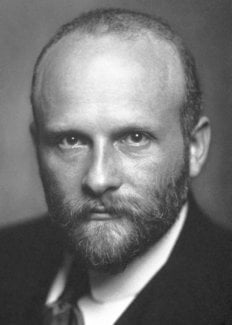Robert Bárány
Biographical

Robert Bárány was born on April 22, 1876, in Vienna. His father was the manager of a farm estate and his mother, Maria Hock, was the daughter of a well-known Prague scientist, and it was her intellectucal influence that was most pronounced in the family. Robert was the eldest of six children. When he was quite young he contracted tuberculosis of the bones, which resulted in permanent stiffness of his kneejoint. It is thought that this illness first led him to take an interest in medicine. The disability, however, did not prevent him from playing tennis and walking in the mountains, right through his life. He was always top of the form – in the primary school, the grammar school, and was among the best of his year even at the university.
After completing his medical studies at Vienna University in 1900, Bárány attended the lectures of Professor C. von Noorden in Frankfurt am Main for one year, and then studied at the psychiatric-neurological clinic of Professor Kracpelin in Freiburg i.Br. It was there that his interest in neurological problems was first awakened. On his return to Vienna he became the pupil of Professor Gussenbauer, the surgeon, and finally, in 1903, accepted a post as demonstrator at the Otological Clinic under Professor Politzer. He followed up the theories of Flourens, Purkinje, Mach, Breuer and others, and clarified the physiology and pathology of human vestibular apparatus. He was awarded the Nobel Prize for his work in this field in 1914. The news of this award reached Bárány in a Russian prisoner-of-war camp; he had been attached to the Austrian army as a civilian surgeon and had tended soldiers with head injuries, which fact had enabled him to continue his neurological studies on the correlation of the vestibular apparatus, the cerebellum and the muscular apparatus. Following the personal intervention of Prince Carl of Sweden on behalf of the Red Cross, he was released from the prisoner-of-war camp in 1916 and was presented with the Nobel Prize by the King of Sweden at Stockholm.
Bárány returned to Vienna the same year, but was bitterly disappointed by the attitude of his Austrian colleagues, who reproached him for having made only incomplete references in his works to the discoveries of other scientists, on whose theories they said his work was based. These attacks resulted in Bárány leaving Vienna to accept the post of Principal and Professor of an Otological Institute in Uppsala, where he remained for the remainder of his life. Holmgren and a number of famous Swedish otologists published a paper in defence of Bárány.
During the latter part of his life Bárány studied the causes of muscular rheurmatism, and continued working on a book dealing with this subject even after he had suffered a stroke and was partially paralysed. Bárány married Ida Felicitas Berger in 1909. They had two sons; the elder became Professor of Pharmacology at the University of Uppsala, his brother Assistant Professor of Medicine at the Caroline Institute, Stockholm; and one daughter, Ingrid, who became a psychiatrist.
He died at Uppsala on April 8, 1936.
This autobiography/biography was written at the time of the award and first published in the book series Les Prix Nobel. It was later edited and republished in Nobel Lectures. To cite this document, always state the source as shown above.
The Nobel Foundation's copyright has expired.Nobel Prizes and laureates
Six prizes were awarded for achievements that have conferred the greatest benefit to humankind. The 14 laureates' work and discoveries range from quantum tunnelling to promoting democratic rights.
See them all presented here.
